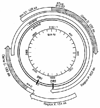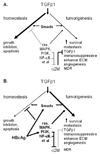Putative roles of hepatitis B x antigen in the pathogenesis of chronic liver disease
- PMID: 19201080
- PMCID: PMC2789742
- DOI: 10.1016/j.canlet.2008.12.010
Putative roles of hepatitis B x antigen in the pathogenesis of chronic liver disease
Abstract
Under most circumstances, hepatitis B virus (HBV) is noncytopathic. However, hepatocellular regeneration that accompanies each bout of hepatitis appears to be associated with increased integration of HBV DNA fragments expressing the virus encoded hepatitis B x antigen (HBxAg). Intrahepatic HBxAg staining correlates with the intensity and progression of chronic liver disease (CLD), and additional work has shown that HBxAg blocks immune mediated killing by Fas and by tumor necrosis factor alpha (TNFalpha). This is not only associated with the blockage of caspase activities by HBxAg, but also by the constitutive stimulation of hepatoprotective pathways, such as nuclear factor kappa B (NF-kappaB), phosphoinositol 3-kinase (PI3K), and beta-catenin (beta-catenin). HBxAg also appears to promote fibrogenesis, by stimulating the production of fibronectin. HBxAg also stimulates the production and activity of transforming growth factor beta1 (TGFbeta1) by several mechanisms, thereby promoting the profibrogenic and tumorigenic properties of this important cytokine. In addition, HBxAg appears to remodel the extracellular matrix (ECM) by altering the expression of several matrix metalloproteinases (MMPs), which may promote tumor metastasis. Hence, HBxAg appears to promote chronic infection by preventing immune mediated apoptosis of infected hepatocytes, by promoting the establishment and persistence of fibrosis and cirrhosis preceding the development of HCC, and by promoting the remodeling of EMC during tumor progression.
Figures




Similar articles
-
The hepatitis B x antigen effector, URG7, blocks tumour necrosis factor alpha-mediated apoptosis by activation of phosphoinositol 3-kinase and beta-catenin.J Gen Virol. 2007 Dec;88(Pt 12):3275-3285. doi: 10.1099/vir.0.83214-0. J Gen Virol. 2007. PMID: 18024896
-
Increased expression of ErbB-2 in liver is associated with hepatitis B x antigen and shorter survival in patients with liver cancer.Int J Cancer. 2009 Oct 15;125(8):1894-901. doi: 10.1002/ijc.24580. Int J Cancer. 2009. PMID: 19610068 Free PMC article.
-
Enhanced cell survival of Hep3B cells by the hepatitis B x antigen effector, URG11, is associated with upregulation of beta-catenin.Hepatology. 2006 Mar;43(3):415-24. doi: 10.1002/hep.21053. Hepatology. 2006. PMID: 16496348
-
Hepatitis B virus X antigen in the pathogenesis of chronic infections and the development of hepatocellular carcinoma.Am J Pathol. 1997 Apr;150(4):1141-57. Am J Pathol. 1997. PMID: 9094970 Free PMC article. Review.
-
Hepatitis B virus X antigen (HBxAg) and cell cycle control in chronic infection and hepatocarcinogenesis.Front Biosci. 2005 May 1;10:1558-72. doi: 10.2741/1640. Front Biosci. 2005. PMID: 15769646 Review.
Cited by
-
Distinct Types of Cell Death and Implications in Liver Diseases: An Overview of Mechanisms and Application.J Clin Transl Hepatol. 2023 Nov 28;11(6):1413-1424. doi: 10.14218/JCTH.2023.00132. Epub 2023 Jul 24. J Clin Transl Hepatol. 2023. PMID: 37719956 Free PMC article. Review.
-
Monoclonal antibody preparation and expression profile analysis of a novel hepatoma associated gene.Pathol Oncol Res. 2014 Apr;20(2):349-56. doi: 10.1007/s12253-013-9703-4. Epub 2013 Nov 9. Pathol Oncol Res. 2014. PMID: 24214030
-
Hepatitis B x antigen (HBx) is an important therapeutic target in the pathogenesis of hepatocellular carcinoma.Oncotarget. 2021 Nov 23;12(24):2421-2433. doi: 10.18632/oncotarget.28077. eCollection 2021 Nov 23. Oncotarget. 2021. PMID: 34853663 Free PMC article.
-
Short chain fatty acids delay the development of hepatocellular carcinoma in HBx transgenic mice.Neoplasia. 2021 May;23(5):529-538. doi: 10.1016/j.neo.2021.04.004. Epub 2021 May 1. Neoplasia. 2021. PMID: 33945993 Free PMC article.
-
Hepatitis B x (HBx) as a Component of a Functional Cure for Chronic Hepatitis B.Biomedicines. 2022 Sep 7;10(9):2210. doi: 10.3390/biomedicines10092210. Biomedicines. 2022. PMID: 36140311 Free PMC article. Review.
References
-
- Beasley RP, Hwang LY, Lin CC, Chien CS. Hepatocellular carcinoma and HBV. A prospective study of 22,707 men in Taiwan. Lancet. 1981;2:1129–1133. - PubMed
-
- Beasley RP, Hwang LY. Epidemiology of hepatocellular carcinoma. In: Vyas GN, Dienstag JL, Hoofnagle JH, editors. Viral Hepatitis and Liver Disease. New York: Grune and Stratton, Inc; 1984. pp. 209–224.
-
- Chisari FV, Ferrari C. Hepatitis B virus immunopathology. Springer Semin. Immunopathol. 1995;17:261–281. - PubMed
-
- Chisari FV, Ferrari C. Hepatitis B virus immunopathogenesis. Annu. Rev. Immunol. 1995;13:29–60. - PubMed
-
- Liaw YF. Hepatitis B virus replication and liver disease progression: the impact of antiviral therapy. Antiviral Ther. 2006;11:669–679. - PubMed
Publication types
MeSH terms
Substances
Grants and funding
LinkOut - more resources
Full Text Sources
Other Literature Sources
Research Materials
Miscellaneous

